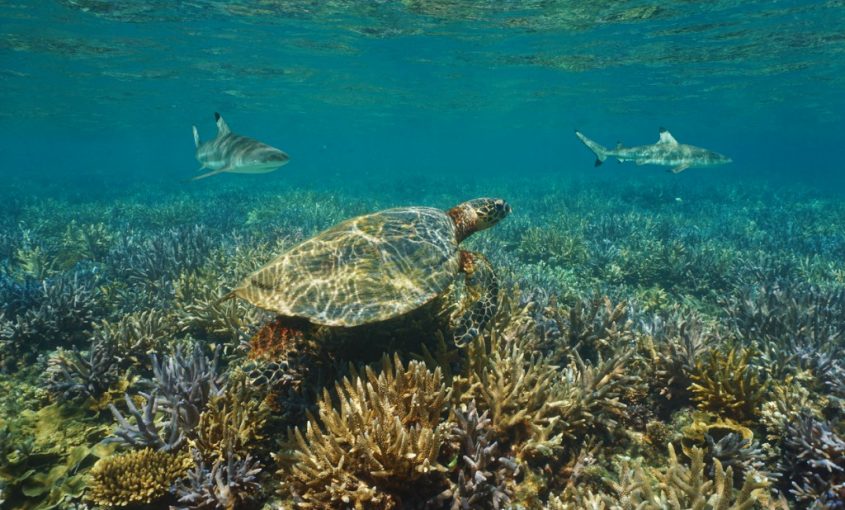Amazing Marine Animals of the Carolina Coast
One of the neat things about visiting the Carolina Coast is learning about (and possibly seeing) some of the amazing marine animals that live in the waters along our shores. It’s important to remember to observe these animals from a distance–especially the dangerous ones–and never harass or harm any of these animals as many are on endangered or threatened species lists.
Dolphins
If you look out to the horizon, you can often see dolphins leaping through the water in the distance. Most dolphins you see are either the common dolphin or the bottlenose dolphin, however, there are nine different species that inhabit our coastal areas. They come closer to the shore to catch fish and some species eat as much as 30 pounds of fish every day. Dolphins travel in small groups called pods, though researchers have seen pods as large as 100 individuals with several different species in the pod.
Sea Turtles
The most common sea turtles in this area are the loggerhead, leatherback or green sea turtle. All of these species have been on the endangered list since the late 1970’s. Sea Turtles come ashore at night during certain parts of the year to dig deep burrows in the sand to bury their eggs in. If you find what you believe to be a sea turtle nest, alert a lifeguard so they can set up protection around the nest. Make sure to fill in any holes you dig and throw away all of your trash as these things are dangerous for our sea turtle populations.
Seals
While seal sightings are rare, gray seals and harbor seals have been seen stopping to take a rest on our shores from time to time. If you see a seal resting on the beach, keep a far distance and don’t touch or harass the animal, which is illegal.
Sharks
The most dangerous and deadly animals you might see during your visit are sharks. Sharks are common in our waters and if sighted close to shore, you should leave the water immediately to avoid being mistaken for food. Several species of sharks are found in our waters including the lemon shark, spinner shark, blacktip shark, hammerhead shark, bull shark, tiger shark and of course, the great white shark. Of these, the ones responsible for the most unprovoked attacks on humans are blacktip sharks, bull sharks, tiger sharks and great white sharks. Bull sharks and tiger sharks are particularly aggressive and opportunistic and will even eat other sharks. They are also far more numerous in our waters than the great white shark. If sharks have been sighted, stay out of the water for your safety and that of rescue crews.
Jellyfish
There are many species of jellyfish of all different colors and types around the world. Along the Carolina Coast, there are seven common species found most frequently. The most common is called the cannonball jellyfish, it doesn’t have stinging tentacles and is not known for being harmful to humans. The Atlantic sea nettle is responsible for most reported jellyfish stings in an average summer and its venomous tentacles pack a powerful sting. Related to jellyfish, though not a true jellyfish itself, the Portuguese Man O’ War is another creature to watch out for with a translucent blue bell–even if it’s dead as the tentacles can still sting after the animal has died. The most venomous and dangerous jellyfish in our waters is the sea wasp with a cube-shaped bell and tentacles hanging from each corner of the cube. Sea wasp stings often are so severe as to require hospitalization. Symptoms of jellyfish stings vary depending on the jellyfish and the severity of the stings but can include shooting pain, intense muscle and joint pain, shock-like sensations, headaches, fever, chills, nausea, vomiting, delirium and fainting.
Along the Carolina Coast, we have some amazing and majestic marine life. Some animals don’t pose hazards to humans but others, such as sharks and jellyfish, you’ll want to avoid at all costs. If you encounter one of these amazing sea animals, observe it respectfully from a distance as many of them are threatened or endangered species. To learn more about these sea creatures, plan a visit to Ripley’s Aquarium while you’re visiting us. You’ll get to see these animals up close in a way that is safe for you and them.


